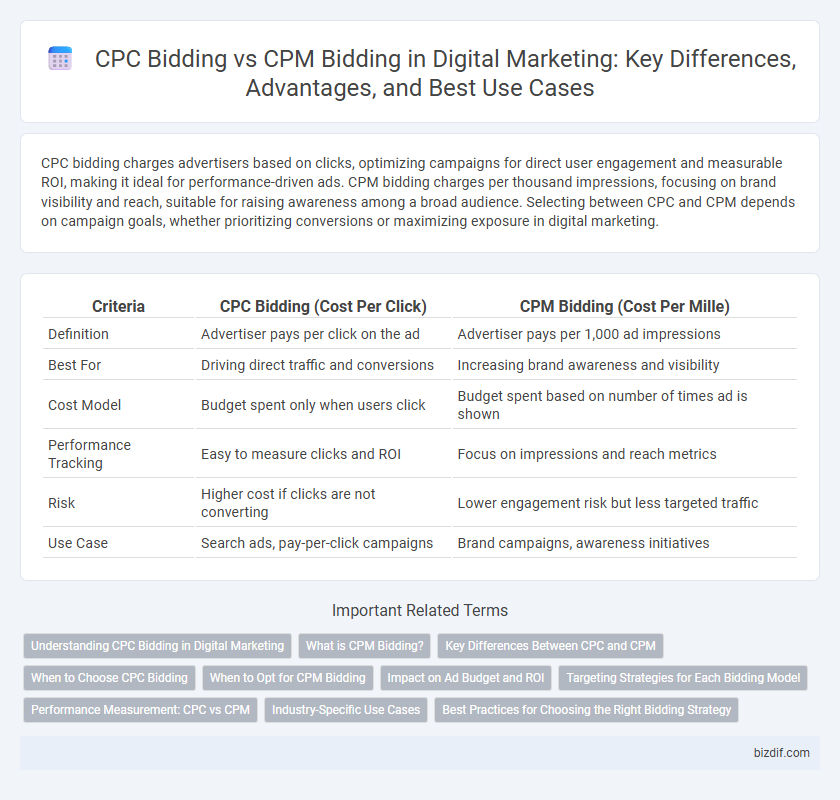CPC bidding charges advertisers based on clicks, optimizing campaigns for direct user engagement and measurable ROI, making it ideal for performance-driven ads. CPM bidding charges per thousand impressions, focusing on brand visibility and reach, suitable for raising awareness among a broad audience. Selecting between CPC and CPM depends on campaign goals, whether prioritizing conversions or maximizing exposure in digital marketing.
Table of Comparison
| Criteria | CPC Bidding (Cost Per Click) | CPM Bidding (Cost Per Mille) |
|---|---|---|
| Definition | Advertiser pays per click on the ad | Advertiser pays per 1,000 ad impressions |
| Best For | Driving direct traffic and conversions | Increasing brand awareness and visibility |
| Cost Model | Budget spent only when users click | Budget spent based on number of times ad is shown |
| Performance Tracking | Easy to measure clicks and ROI | Focus on impressions and reach metrics |
| Risk | Higher cost if clicks are not converting | Lower engagement risk but less targeted traffic |
| Use Case | Search ads, pay-per-click campaigns | Brand campaigns, awareness initiatives |
Understanding CPC Bidding in Digital Marketing
CPC bidding in digital marketing charges advertisers only when a user clicks on their ad, ensuring cost efficiency by directly targeting user engagement. This bidding strategy is ideal for campaigns aiming to drive website traffic, lead generation, and measurable conversions. Advertisers benefit from precise budget control and optimized ad placements based on click performance metrics.
What is CPM Bidding?
CPM bidding, or Cost Per Mille bidding, is a digital marketing strategy where advertisers pay for every 1,000 impressions their ad receives. This model is optimal for brand awareness campaigns aiming to maximize visibility rather than direct clicks or conversions. CPM bidding allows advertisers to control costs while targeting specific audiences on platforms like Google Ads and Facebook Ads.
Key Differences Between CPC and CPM
CPC bidding charges advertisers based on each click their ads receive, making it ideal for campaigns focused on driving direct user actions and website traffic. CPM bidding charges per thousand impressions, prioritizing brand visibility and reach over immediate engagement. The choice between CPC and CPM depends on campaign goals, as CPC optimizes for performance and conversions, while CPM maximizes exposure and brand awareness.
When to Choose CPC Bidding
Choose CPC bidding when campaigns prioritize direct user actions, such as clicks, website visits, or conversions, ensuring budget is spent only on engaged audiences. This bidding strategy maximizes ROI for performance-driven goals like lead generation or e-commerce sales by targeting cost per click instead of impressions. CPC bidding is ideal for advertisers aiming to control costs closely and measure the effectiveness of ads based on interaction rather than mere visibility.
When to Opt for CPM Bidding
Opt for CPM bidding when brand awareness and ad visibility are the primary goals, as it charges advertisers based on impressions rather than clicks, ensuring maximum exposure to the target audience. CPM bidding is ideal for campaigns aiming to boost reach across large demographics, especially in industries like retail and entertainment where visual impact drives engagement. This strategy works best when advertisers prioritize frequency and impression volume over direct user actions like clicks or conversions.
Impact on Ad Budget and ROI
CPC bidding directly ties costs to actual clicks, allowing marketers to optimize ad spend for engagement and maximize ROI by paying only for user interactions. CPM bidding charges based on impressions, which can inflate costs without guaranteed user action, potentially reducing ROI if the ad fails to convert viewers. Selecting CPC bidding often provides better budget control and higher return on investment, particularly for campaigns focused on driving traffic or conversions.
Targeting Strategies for Each Bidding Model
CPC bidding targets users based on intent and engagement by focusing on ad clicks, making it ideal for campaigns aimed at driving direct conversions and precise audience actions. CPM bidding prioritizes reach and brand awareness by charging per thousand impressions, effectively targeting broader demographics to maximize visibility and exposure. Selecting CPC or CPM depends on campaign goals, with CPC strategies favoring performance-driven targeting models and CPM strategies leveraging demographic and behavioral data for expansive audience coverage.
Performance Measurement: CPC vs CPM
CPC bidding measures performance by the cost paid for each individual click, making it ideal for campaigns focused on driving direct user actions and maximizing ROI on engagement. CPM bidding charges based on impressions, optimizing for brand awareness and reach by ensuring ads are seen by as many users as possible. Marketers should choose CPC for precise tracking of conversion-driven campaigns, while CPM suits campaigns aiming at broad visibility and audience exposure.
Industry-Specific Use Cases
CPC bidding is ideal for industries like e-commerce and lead generation where direct user actions, such as clicks or conversions, drive campaign success metrics. CPM bidding suits brand awareness campaigns predominant in sectors like entertainment and FMCG, where maximizing ad impressions boosts visibility to a broader audience. Selecting the right bidding model depends on campaign objectives and industry-specific performance indicators to optimize digital marketing ROI.
Best Practices for Choosing the Right Bidding Strategy
CPC bidding is ideal for campaigns focused on driving direct actions like clicks and conversions, optimizing budget efficiency by paying only when users engage. CPM bidding suits brand awareness goals by maximizing impressions and reach, ensuring broad visibility at a fixed cost per thousand views. Evaluating campaign objectives, target audience behavior, and key performance indicators helps marketers select the optimal bidding strategy for higher ROI in digital advertising.
CPC Bidding vs CPM Bidding Infographic

 bizdif.com
bizdif.com